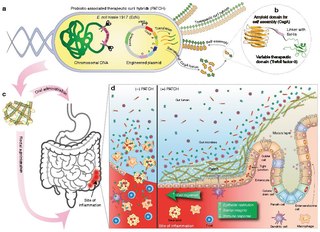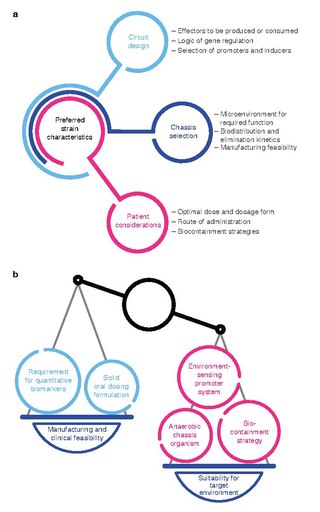
Bonnie Lynn Bassler is an American molecular biologist; the Squibb Professor in Molecular Biology and chair of the Department of Molecular Biology at Princeton University; and a Howard Hughes Medical Institute Investigator. She has researched cell-to-cell chemical communication in bacteria and discovered key insights into the mechanism by which bacteria communicate, known as quorum sensing. She has contributed to the idea that disruption of chemical signaling can be used as an antimicrobial therapy.

Synthetic biology (SynBio) is a multidisciplinary field of science that focuses on living systems and organisms, and it applies engineering principles to develop new biological parts, devices, and systems or to redesign existing systems found in nature.
Tom Knight is an American synthetic biologist and computer engineer, who was formerly a senior research scientist at the MIT Computer Science and Artificial Intelligence Laboratory, a part of the MIT School of Engineering. He now works at the synthetic biology company Ginkgo Bioworks, which he cofounded in 2008.
Pamela Ann Silver is an American cell and systems biologist and a bioengineer. She holds the Elliot T. and Onie H. Adams Professorship of Biochemistry and Systems Biology at Harvard Medical School in the Department of Systems Biology. Silver is one of the founding Core Faculty Members of the Wyss Institute for Biologically Inspired Engineering at Harvard University.

The L'Oréal-UNESCO For Women in Science Awards, created in 1998, aim to improve the position of women in science by recognizing outstanding women researchers who have contributed to scientific progress. The awards are a result of a partnership between the French company L'Oréal and the United Nations Educational, Scientific and Cultural Organization (UNESCO) and carry a grant of $100,000 USD for each laureate. This award is also known as the L'Oréal-UNESCO Women in Science Awards.

Joan Elaine Argetsinger Steitz is Sterling Professor of Molecular Biophysics and Biochemistry at Yale University and Investigator at the Howard Hughes Medical Institute. She is known for her discoveries involving RNA, including ground-breaking insights into how ribosomes interact with messenger RNA by complementary base pairing and that introns are spliced by small nuclear ribonucleic proteins (snRNPs), which occur in eukaryotes. In September 2018, Steitz won the Lasker-Koshland Award for Special Achievement in Medical Science. The Lasker award is often referred to as the 'American Nobel' because 87 of the former recipients have gone on to win Nobel prizes.

BioBrick parts are DNA sequences which conform to a restriction-enzyme assembly standard. These building blocks are used to design and assemble larger synthetic biological circuits from individual parts and combinations of parts with defined functions, which would then be incorporated into living cells such as Escherichia coli cells to construct new biological systems. Examples of BioBrick parts include promoters, ribosomal binding sites (RBS), coding sequences and terminators.

Sissel Tolaas is a Norwegian artist and researcher known for her work with smell.

OS Fund is an American venture capital fund that invests in early-stage science and technology companies.
Cellular agriculture focuses on the production of agricultural products from cell cultures using a combination of biotechnology, tissue engineering, molecular biology, and synthetic biology to create and design new methods of producing proteins, fats, and tissues that would otherwise come from traditional agriculture. Most of the industry is focused on animal products such as meat, milk, and eggs, produced in cell culture rather than raising and slaughtering farmed livestock which is associated with substantial global problems of detrimental environmental impacts, animal welfare, food security and human health. Cellular agriculture is a field of the biobased economy. The most well known cellular agriculture concept is cultured meat.
Ginkgo Bioworks is an American biotech company founded in 2008 by five scientists from MIT, headed by Jason Kelly. The company specializes in using genetic engineering to produce bacteria with industrial applications for other biotech companies, saving other companies the cost of reproducing the initial stages of design in synthetic biology. The self-proclaimed "Organism Company" was one of the world's largest privately held biotech companies, valued at $4.2 billion in 2019. It raised $290 million in September and $350 million in October of that year. Ginkgo Bioworks went public on the New York Stock Exchange via a SPAC merger on September 17, 2021.
Karmella Ann Haynes is a biomedical engineer and associate professor at the Wallace H. Coulter Department of Biomedical Engineering, Georgia Institute of Technology and Emory University. She researches how chromatin is used to control cell development in biological tissue.
Natsai Audrey Chieza is a designer and the founder of Faber Futures, a R&D studio that creates biologically inspired materials. She gave a 2017 TED talk on fashion's problem with pollution. She is Designer in Residence at Ginkgo Bioworks.

Synthetic microbial consortia or Synthetic microbial communities are multi-population systems that can contain a diverse range of microbial species, and are adjustable to serve a variety of industrial, ecological, and tautological interests. For synthetic biology, consortia take the ability to engineer novel cell behaviors to a population level.
Rachel Dutton is an American microbiologist. She has developed the microorganisms that live on cheese into a model system for complex interacting microbial communities. She has worked with chefs including Dan Felder, head of research and development at Momofuku to develop new fermentation procedures to be used in food and has been called the "go-to microbiologist" for chefs and gastronomists.

A living medicine is a type of biologic that consists of a living organism that is used to treat a disease. This usually takes the form of a cell or a virus that has been genetically engineered to possess therapeutic properties that is injected into a patient. Perhaps the oldest use of a living medicine is the use of leeches for bloodletting, though living medicines have advanced tremendously since that time.

Bacterial therapy is the therapeutic use of bacteria to treat diseases. Bacterial therapeutics are living medicines, and may be wild type bacteria or bacteria that have been genetically engineered to possess therapeutic properties that is injected into a patient. Other examples of living medicines include cellular therapeutics, activators of anti-tumor immunity, or synergizing with existing tools and approaches. and phage therapeutics, or as delivery vehicles for treatment, diagnosis, or imaging, complementing or synergizing with existing tools and approaches.

Alexandra Daisy Ginsberg is a British and South African artist who lives and works in London, UK. She is known for artworks that explore the relationship between humans, technology and nature. Many of her works are achieved using artificial intelligence and synthetic biology.
Zymergen was an American biotechnology company based in Emeryville, California. The company applies genomics and machine learning to research and design chemical producing genetically modified organisms. It claimed that its manufacturing process was safer and cheaper than traditional manufacturing, but was unable to demonstrate this. Shortly after going public in 2021, it was reported that the company was facing difficulties in manufacturing and struggling to make revenue. In July 2022, Ginkgo Bioworks agreed to acquire Zymergen for $300 million.

Renee Diane Wegrzyn is an American applied biologist who has served as the inaugural director of the Advanced Research Projects Agency for Health since October 2022.












